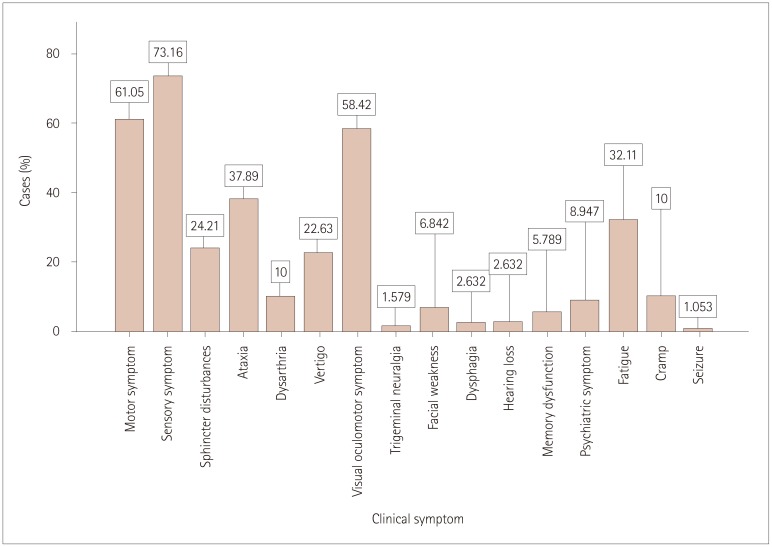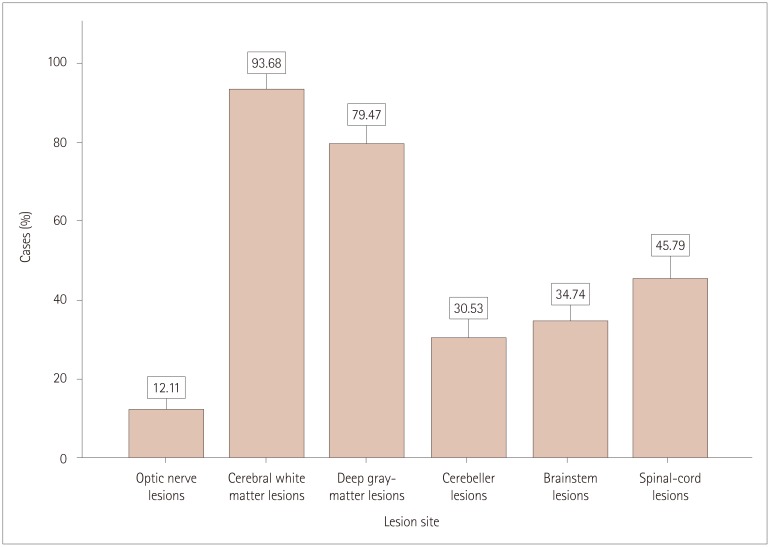J Clin Neurol.
2018 Jul;14(3):359-365. 10.3988/jcn.2018.14.3.359.
Clinical Presentations and Phenotypic Spectrum of Multiple Sclerosis at a University Hospital in Saudi Arabia
- Affiliations
-
- 1Department of Neurology, College of Medicine, Imam Abdulrahman Bin Faisal University, Dammam, Saudi Arabia. snmohammadali@iau.edu.sa
- KMID: 2415053
- DOI: http://doi.org/10.3988/jcn.2018.14.3.359
Abstract
- BACKGROUND AND PURPOSE
The objective of this study was to determine the frequencies of different clinical presentations and the phenotypic spectrum of multiple sclerosis (MS).
METHODS
This cross-sectional study was performed in the Neurology Department of King Fahd Hospital of University Alkhobar in the Kingdom of Saudi Arabia (KSA). Data of 190 MS patients who fulfilled the McDonald criteria were retrieved from medical records and analyzed.
RESULTS
The age at disease onset was 26.27±8.2 years (mean±SD) and disease duration was 6.38±5.10 years. The male-to-female ratio was 1:1.6. Optic neuritis and myelitis were the most-frequent first clinical presentations. Sensory (73.1%), motor (61%), and visual (58.4%) symptoms were the most-frequent established clinical symptoms. Relapsing-remitting multiple sclerosis (RRMS) was present in 75% of the cases. Supratentorial T2-weighted white-matter lesions and deep-gray-matter or juxtacortical lesions were the most-frequent magnetic resonance imaging (MRI) lesions, comprising 28% and 23.7% of all MRI lesions observed in 93.6% and 79.4% of the cases, respectively. The scores on the Expanded Disability Status Scale were within the range of 1.0-5.5 in 82.1% of the patients. There were 145 (76.3%) patients taking interferon β therapy.
CONCLUSIONS
MS presenting in the hospital setting is more common in KSA than reported previously, and the number of diagnosed cases in increasing. It is therefore an emerging and disabling neurological illness in KSA with clinical characteristics not dissimilar to those in other middle eastern countries. A decrease in the frequency of patients with secondary progressive multiple sclerosis (SPMS) indicates either that more new cases of RRMS are being diagnosed or that adequate treatments of RRMS are preventing the evolution to SPMS. Further larger and population-wide epidemiological and clinical studies with the long-term follow-up of MS patients are required to better assess the clinical spectrum of MS in KSA.
Keyword
MeSH Terms
Figure
Reference
-
1. Richards RG, Sampson FC, Beard SM, Tappenden P. A review of the natural history and epidemiology of multiple sclerosis: implications for resource allocation and health economic models. Health Technol Assess. 2002; 6:1–73.
Article2. Lublin FD. New multiple sclerosis phenotypic classification. Eur Neurol. 2014; 72(Suppl 1):1–5.
Article3. Weinshenker BG. Natural history of multiple sclerosis. Ann Neurol. 1994; 36(Suppl):S6–S11. PMID: 8017890.
Article4. Miller DH, Chard DT, Ciccarelli O. Clinically isolated syndromes. Lancet Neurol. 2012; 11:157–169. PMID: 22265211.
Article5. Rice CM, Cottrell D, Wilkins A, Scolding NJ. Primary progressive multiple sclerosis: progress and challenges. J Neurol Neurosurg Psychiatry. 2013; 84:1100–1106. PMID: 23418213.
Article6. Eriksson M, Andersen O, Runmarker B. Long-term follow up of patients with clinically isolated syndromes, relapsing-remitting and secondary progressive multiple sclerosis. Mult Scler. 2003; 9:260–274. PMID: 12814173.7. Scalfari A, Neuhaus A, Daumer M, Deluca GC, Muraro PA, Ebers GC. Early relapses, onset of progression, and late outcome in multiple sclerosis. JAMA Neurol. 2013; 70:214–222. PMID: 23407713.
Article8. Lublin FD, Reingold SC, Cohen JA, Cutter GR, Sørensen PS, Thompson AJ, et al. Defining the clinical course of multiple sclerosis: the 2013 revisions. Neurology. 2014; 83:278–286. PMID: 24871874.
Article9. Evans C, Beland SG, Kulaga S, Wolfson C, Kingwell E, Marriott J, et al. Incidence and prevalence of multiple sclerosis in the Americas: a systematic review. Neuroepidemiology. 2013; 40:195–210. PMID: 23363936.
Article10. Kingwell E, Marriott JJ, Jetté N, Pringsheim T, Makhani N, Morrow SA, et al. Incidence and prevalence of multiple sclerosis in Europe: a systematic review. BMC Neurol. 2013; 13:128. PMID: 24070256.
Article11. Alroughani R, Ahmed SF, Behbahani R, Khan R, Thussu A, Alexander KJ, et al. Increasing prevalence and incidence rates of multiple sclerosis in Kuwait. Mult Scler. 2014; 20:543–547. PMID: 24025709.
Article12. Deleu D, Mir D, Al Tabouki A, Mesraoua R, Mesraoua B, Akhtar N, et al. Prevalence, demographics and clinical characteristics of multiple sclerosis in Qatar. Mult Scler. 2013; 19:816–819. PMID: 22968545.
Article13. Kalanie H, Gharagozli K, Kalanie AR. Multiple sclerosis: report on 200 cases from Iran. Mult Scler. 2003; 9:36–38. PMID: 12617266.
Article14. Kingwell E, Zhu F, Marrie RA, Fisk JD, Wolfson C, Warren S, et al. High incidence and increasing prevalence of multiple sclerosis in British Columbia, Canada: findings from over two decades (1991–2010). J Neurol. 2015; 262:2352–2363. PMID: 26205633.
Article15. Viswanathan S, Rose N, Masita A, Dhaliwal JS, Puvanarajah SD, Rafia MH, et al. Multiple sclerosis in Malaysia: demographics, clinical features, and neuroimaging characteristics. Mult Scler Int. 2013; 2013:614716. PMID: 24455266.
Article16. Idris MN, Sokrab TE, Ibrahim EA, Ali HE, Elzibair MA, Abadalatif M, et al. Multiple sclerosis in Sudan: a prospective study of clinical presentation and outcome. Mult Scler. 2009; 15:1537–1538. PMID: 20019098.
Article17. Ebers GC. Environmental factors and multiple sclerosis. Lancet Neurol. 2008; 7:268–277. PMID: 18275928.
Article18. Pugliatti M, Harbo HF, Holmøy T, Kampman MT, Myher KM, Riise T, et al. Environmental risk factors in multiple sclerosis. Acta Neurol Scand Suppl. 2008; 188:34–40. PMID: 18439219.
Article19. Naeem Z. Vitamin D deficiency- an ignored epidemic. Int J Health Sci (Qassim). 2010; 4:V–VI.20. Pugliatti M, Sotgiu S, Rosati G. The worldwide prevalence of multiple sclerosis. Clin Neurol Neurosurg. 2002; 104:182–191. PMID: 12127652.
Article21. Polman CH, Reingold SC, Banwell B, Clanet M, Cohen JA, Filippi M, et al. Diagnostic criteria for multiple sclerosis: 2010 revisions to the McDonald criteria. Ann Neurol. 2011; 69:292–302. PMID: 21387374.
Article22. Bohlega S, Inshasi J, Al Tahan AR, Madani AB, Qahtani H, Rieckmann P. Multiple sclerosis in the Arabian Gulf countries: a consensus statement. J Neurol. 2013; 260:2959–2963. PMID: 23504049.
Article23. Yaqub BA, Daif AK. Multiple sclerosis in Saudi Arabia. Neurology. 1988; 38:621–623. PMID: 3352920.
Article24. Daif AK, Al-Rajeh S, Awada A, Al Bunyan M, Ogunniyi A, AbdulJabar M, et al. Pattern of presentation of multiple sclerosis in Saudi Arabia: analysis based on clinical and paraclinical features. Eur Neurol. 1998; 39:182–186. PMID: 9605397.
Article25. Browne P, Chandraratna D, Angood C, Tremlett H, Baker C, Taylor BV, et al. Atlas of multiple sclerosis 2013: a growing global problem with widespread inequity. Neurology. 2014; 83:1022–1024. PMID: 25200713.
Article26. Milo R, Kahana E. Multiple sclerosis: geoepidemiology, genetics and the environment. Autoimmun Rev. 2010; 9:A387–A394. PMID: 19932200.
Article27. El-Salem K, Al-Shimmery E, Horany K, Al-Refai A, Al-Hayk K, Khader Y. Multiple sclerosis in Jordan: a clinical and epidemiological study. J Neurol. 2006; 253:1210–1216. PMID: 16649096.
Article28. Etemadifar M, Abtahi SH, Akbari M, Murray RT, Ramagopalan SV, Fereidan-Esfahani M. Multiple sclerosis in Isfahan, Iran: an update. Mult Scler. 2014; 20:1145–1147. PMID: 24326673.
Article29. Tallawy HN, Farghaly WM, Rageh TA, Shehata GA, Badry R, Metwally NA, et al. Door-to-door survey of major neurological disorders (project) in Al Quseir City, Red Sea Governorate, Egypt. Neuropsychiatr Dis Treat. 2013; 9:767–771. PMID: 23745047.30. Shahwar H, Akhter SW, Ali S. Clinical spectrum of multiple sclerosis at a tertiary care hospital in Pakistan. Pak J Med Sci. 2008; 24:221–226.31. Inshasi J, Thakre M. Prevalence of multiple sclerosis in Dubai, United Arab Emirates. Int J Neurosci. 2011; 121:393–398. PMID: 21463177.
Article32. Alroughani R, Ahmed SF, Al-Hashel J. Demographics and clinical characteristics of multiple sclerosis in Kuwait. Eur Neurol. 2014; 72:181–185. PMID: 25227152.
Article33. Barkhof F, Filippi M, Miller DH, Scheltens P, Campi A, Polman CH, et al. Comparison of MRI criteria at first presentation to predict conversion to clinically definite multiple sclerosis. Brain. 1997; 120:2059–2069. PMID: 9397021.
Article34. Montalban X, Tintoré M, Swanton J, Barkhof F, Fazekas F, Filippi M, et al. MRI criteria for MS in patients with clinically isolated syndromes. Neurology. 2010; 74:427–434. PMID: 20054006.
Article35. Ontaneda D, Fox RJ. Progressive multiple sclerosis. Curr Opin Neurol. 2015; 28:237–243. PMID: 25887766.
Article36. Tanaka K, Kujuro Y, Suzuki S, Tanahashi N, Hamada J, Nogawa S, et al. Clinical and laboratory features of in-patients with multiple sclerosis in a University Hospital in Tokyo from 1988–2002. Intern Med. 2005; 44:560–566. PMID: 16020880.
Article37. Negreiros AA, Sousa-Munõz RL, Oliveira BE, Nóbrega PV, Monteiro LL. Clinical and epidemiological profile of patients diagnosed with multiple sclerosis in João Pessoa, Paraiba, Brazil. Arq Neuropsiquiatr. 2015; 73:741–745. PMID: 26352490.
- Full Text Links
- Actions
-
Cited
- CITED
-
- Close
- Share
- Similar articles
-
- Missense Mutations in the CTSC Gene in Saudi Families Segregating Papillon-Lefèvre Syndrome
- A Laboratory-Based Study for First Documented Case of Urinary Myiasis Caused by Larvae of Megaselia scalaris (Diptera: Phoridae) in Saudi Arabia
- Differential Diagnosis between Multiple Sclerosis and Neuromyelitis Optica Spectrum Disorder
- The SLC29A3 variant, neutrophilic dermatosis, and hyperferritinemia imitate systemic juvenile idiopathic arthritis in a Saudi child: a case report
- Patterns of Helicobacter pylori Resistance to Metronidazole, Clarithormycin and Amoxicillin in Saudi Arabia



